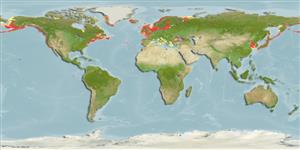Classification / Names
Common names from other countries
Main reference
Size / Weight / Age
Max length : 11.0 cm TL male/unsexed; (Ref. 35388); common length : 5.1 cm TL male/unsexed; (Ref. 1998); max. reported age: 8 years (Ref. 72489)
Length at first maturity
Lm 5.5 range ? - ? cm
Environment
Marine; freshwater; brackish; benthopelagic; anadromous (Ref. 51243); depth range 0 - 100 m (Ref. 50550)
Climate / Range
Temperate; 4°C - 20°C (Ref. 1672), preferred 7°C (Ref. 107945); 71°N - 26°N, 117°E - 60°E (Ref. 26213)
Distribution
Circumarctic and temperate regions: Extending south to the Black Sea, southern Italy, Iberian Peninsula, North Africa; in Eastern Asia north of Japan (35°N), in North America north of 30-32°N; Greenland.
Countries | FAO areas | Ecosystems | Occurrences | Introductions
Short description
Dorsal
spines
(total): 2 - 4;
Dorsal
soft rays
(total): 10-14;
Anal
spines: 1;
Anal
soft rays: 8 - 10;
Vertebrae: 29 - 33. Distinguished uniquely from its congeners in Europe by having trunk and caudal peduncle covered by a complete series of 29-35 bony scutes. Other characters important to separate this species from other species of the genus include posterior edge of scutes crenulated and scutes forming a lateral keel on caudal peduncle. Scutes may be missing on posterior part of trunk in hybrid zone with Gasterosteus gymnurus and in some isolated freshwater populations of northeastern Europe (Ref. 59043). Identified by the 3 to 4 sharp, free spines before the dorsal fin, the pelvic fin reduced to a sharp spine and a small ray, and the series of plates along the sides of the body (Ref. 27547). Gill rakers long and slender, 17 to 25 on the first arch or strictly freshwater forms, 1 or 2 more in anadromous forms; lateral line with microscopic pores (Ref. 27547). The anadromous form is fully plated, with up to 37 plates on the sides and a rather pronounced keel on each side of the caudal peduncle (Ref. 27547). Dorsal spines separated from each other and from the soft-rayed fins, each spine having a reduced membrane attached to its posterior side; anal spine free from rest of the fin; posterior margin of pectorals nearly truncate; caudal truncate to slightly indented (Ref. 27547). Freshwater forms usually mottled brown or greenish; anadromous forms silvery green to bluish black (Ref. 27547). A few isolated populations are black (Ref. 27547). Sides usually pale; belly yellow, white or silvery (Ref. 27547). Fins pale; pectoral rays often have dark dots (Ref. 27547). Breeding males (except for black forms) become brilliant bluish or green with blue or green eyes, and the forward part of the body, especially the breast region, turns bright red or orange (Ref. 27547). Caudal fin with 12 rays (Ref. 2196).
IUCN Red List Status (Ref. 115185)
Threat to humans
Harmless
Human uses
Fisheries: minor commercial; aquarium: public aquariums
Tools
Special reports
Download XML
Internet sources
Estimates of some properties based on models
Phylogenetic diversity index
PD50 = 0.5156 many relatives (e.g. carps) 0.5 - 2.0 few relatives (e.g. lungfishes)
Trophic Level
3.3 ±0.2 se; Based on diet studies.
Resilience
High, minimum population doubling time less than 15 months (K=0.6-1.8; tm=1; tmax=4; Fec=80)
Vulnerability
Low vulnerability (10 of 100)
Price category
